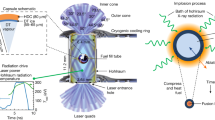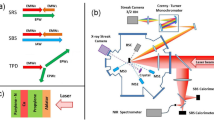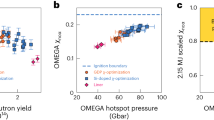Abstract
Modern high-power lasers can generate extreme states of matter that are relevant to astrophysics1, equation-of-state studies2 and fusion energy research3,4. Laser-driven implosions of spherical polymer shells have, for example, achieved an increase in density of 1,000 times relative to the solid state5. These densities are large enough to enable controlled fusion, but to achieve energy gain a small volume of compressed fuel (known as the ‘spark’) must be heated to temperatures of about 108 K (corresponding to thermal energies in excess of 10 keV). In the conventional approach to controlled fusion, the spark is both produced and heated by accurately timed shock waves4, but this process requires both precise implosion symmetry and a very large drive energy. In principle, these requirements can be significantly relaxed by performing the compression and fast heating separately6,7,8,9,10; however, this ‘fast ignitor’ approach7 also suffers drawbacks, such as propagation losses and deflection of the ultra-intense laser pulse by the plasma surrounding the compressed fuel. Here we employ a new compression geometry that eliminates these problems; we combine production of compressed matter in a laser-driven implosion with picosecond-fast heating by a laser pulse timed to coincide with the peak compression. Our approach therefore permits efficient compression and heating to be carried out simultaneously, providing a route to efficient fusion energy production.
This is a preview of subscription content, access via your institution
Access options
Subscribe to this journal
Receive 51 print issues and online access
$199.00 per year
only $3.90 per issue
Buy this article
- Purchase on Springer Link
- Instant access to full article PDF
Prices may be subject to local taxes which are calculated during checkout




Similar content being viewed by others
References
Remington, B. A., Arnet, D., Drake, R. P. & Takabe, H. Modeling astrophysical phenomena in the laboratory with intense lasers. Science 284, 1488–1493 (1999).
Ichimaru, S. & Kitamura, H. Pycnonuclear reactions in dense astrophysical and fusion plasmas. Phys. Plasmas 6, 2649–2671 (1999).
Nuckolls, J., Wood, L., Thiessen, A. & Zimmerman, G. Laser compression of matter to super-high densities. Nature 239, 139–142 (1972).
Lindl, J., McCrory, R. L. & Campbell, E. M. Progress toward ignition and burn propagation in inertial confinement fusion. Phys. Today 45, 32–40 (1992).
Azechi, H. et al. High density compression experiments at ILE, Osaka. Laser Part. Beams 9, 193–207 (1991).
Piriz, A. R. & Sanchez, M. M. Analytical model for the dynamics of fast ignition. Phys. Plasmas 5, 2721–2726 (1998).
Tabak, M. et al. Ignition and high gain with ultrapowerful lasers. Phys. Plasmas 1, 1626–1634 (1994).
Atzeni, S. Inertial fusion fast ignitor: Igniting pulse parameter window vs the penetration depth of the heating particles and the density of the precompressed fuel. Phys. Plasmas 6, 3316–3326 (1999).
Norreys, P. et al. Experimental studies of the advanced fast ignitor scheme. Phys. Plasmas 7, 3721–3726 (2000).
Kodama, R. et al. Fast ignition research at the institute of laser engineering Osaka University. Phys. Plasmas (in the press).
Perry, M. D. & Mourrou, G. Terawatt to petawatt subpicosecond lasers. Science 264, 917–924 (1994).
Kruer, W. E. & Estabrook, K. JxB heating by very intense laser light. Phys. Fluids 28, 430–432 (1985).
Brunel, F. Not-so-resonant, resonant absorption. Phys. Rev. Lett. 59, 52–55 (1987).
Lefebvre, E. & Bonnaud, G. Transparency/opacity of a solid target illuminated by an ultrahigh-intensity laser pulse. Phys. Rev. Lett. 74, 2002–2005 (1995).
Malka, G. & Miquel, J. L. Experimental validation of the linear theory of stimulated Raman scattering driven by a 500-fs laser pulse in a preformed underdense plasma. Phys. Rev. Lett. 74, 4655–4658 (1996).
Pukhov, A. & Meyer-ter-Vehn, J. Laser hole boring into overdense plasma and relativistic electron currents for fast ignition of ICF targets. Phys. Rev. Lett. 79, 2686–2689 (1997).
Key, M. H. et al. Hot electron production and heating by hot electrons in fast ignitor research. Phys. Plasmas 5, 1966–1972 (1998).
Kodama, R. et al. Long-scale jet formation with specularly reflected light in ultraintense laser-plasma interactions. Phys. Rev. Lett. 84, 674–677 (2000).
Santala, M. I. K. et al. Effect of the plasma density scale length on the direction of fast electrons in relativistic laser-solid interactions. Phys. Rev. Lett. 84, 1459–1463 (2000).
Tanaka, K. A. et al. Studies of ultra-intense laser plasma interactions for fast ignition. Phys. Plasmas 7, 2014–2022 (2000).
Wharton, K. B. et al. Experimental measurements of hot electrons generated by ultraintense (>1019W/cm2) laser plasma interactions on solid-density targets. Phys. Rev. Lett. 81, 822–825 (1998).
Kodama, R. et al. Development of a two-dimensional space-resolved high speed sampling camera. Rev. Sci. Instrum. 70, 625–628 (1999).
Davies, J. R., Bell, A. R. & Tatarakis, M. Magnetic focusing and trapping of high-intensity laser generated fast electrons at the rear of solid targets. Phys. Rev. E 59, 6032–6036 (1999).
Tatarakis, M. et al. Plasma formation on the front and rear of plastic targets due to high-intensity laser-generated fast electrons. Phy. Rev. Lett. 81, 999–1002 (1998).
Honda, M., Meyer-ter-Vehn, J. & Pukhov, A. Collective stopping and ion heating in relativistic-electron-beam transport for fast ignition. Phys. Rev. Lett. 85, 2128–2131 (2000).
Kato, Y et al. Fast ignition and related plasma physics issues with high-intensity lasers. Plasma Phys. Control. Fusion 39, 145–151 (1997).
Duda, B. J., Hemker, R. G., Tzeng, K. C. & Mori, W. B. A long-wavelength hosing instability in laser-plasma interactions. Phys. Rev. Lett. 83, 1978–1981 (1999).
Hain, S., Cornolti, F. & Opower, H. Hydrodynamic models and schemes for fast ignition. Laser Part. Beams 17, 245–263 (1999).
Sunahara, A., Takabe, H & Mima, K. 2D simulation of hydrodynamic instability in ICF stagnation phase. Fusion Eng. Design 44, 163–169 (1999).
Acknowledgements
We thank the mm-Wave Technology Centre at the Rutherford Appleton Laboratory, and the target fabrication, laser operation and data acquisition groups at ILE Osaka University. This work was supported by the Japan Society for the Promotion of Science, and the UK Royal Society.
Author information
Authors and Affiliations
Corresponding author
Rights and permissions
About this article
Cite this article
Kodama, R., Norreys, P., Mima, K. et al. Fast heating of ultrahigh-density plasma as a step towards laser fusion ignition. Nature 412, 798–802 (2001). https://doi.org/10.1038/35090525
Received:
Accepted:
Issue Date:
DOI: https://doi.org/10.1038/35090525
This article is cited by
-
Swept coded aperture real-time femtophotography
Nature Communications (2024)
-
Beam-Driven Growth of Lower Hybrid Wave in a Magnetized Relativistic Beam-Plasma System
Journal of Fusion Energy (2023)
-
PIC Simulation of the Nonlinear Phenomena in Electrostatic Wave Breaking Regime: Magnetized Warm Plasma
Brazilian Journal of Physics (2023)
-
Focused Energy, A New Approach Towards Inertial Fusion Energy
Journal of Fusion Energy (2023)
-
Super-strong magnetic field-dominated ion beam dynamics in focusing plasma devices
Scientific Reports (2022)
Comments
By submitting a comment you agree to abide by our Terms and Community Guidelines. If you find something abusive or that does not comply with our terms or guidelines please flag it as inappropriate.



